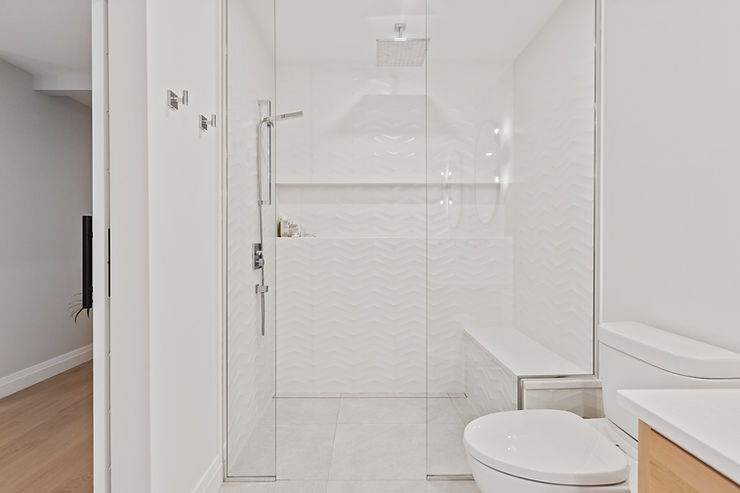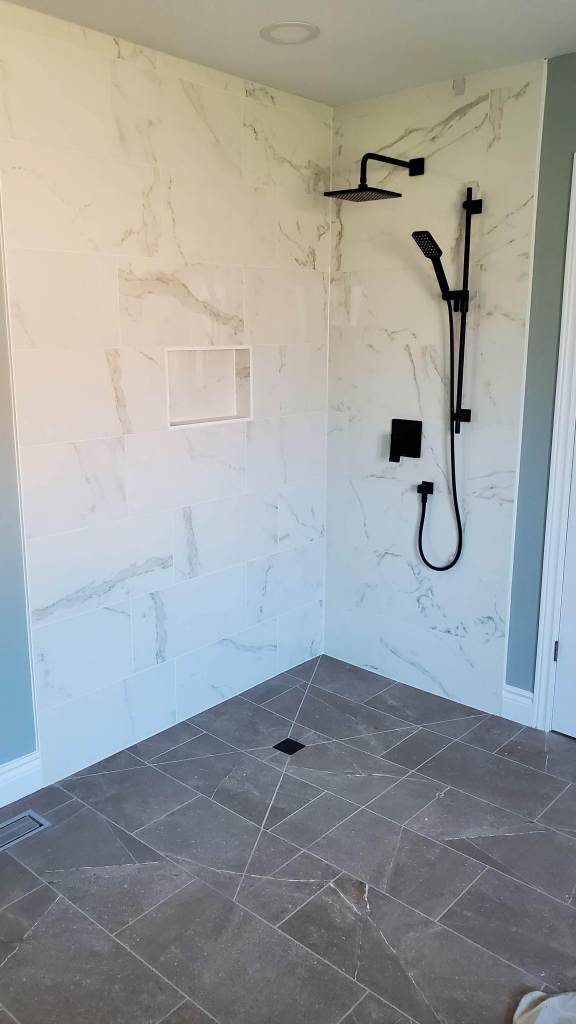Should I Replace A Tub With A Walk-In Shower? (Ontario)
Should I Replace a Tub With a Walk-in Shower?

Everything You Need to Know About Converting a Bathtub to a Shower
As homeowners strive for a more modern, accessible bathroom design, one of the most common upgrades is converting a bathtub to a walk-in shower. But if this switch means eliminating the only tub in the house, there are a few essential factors to consider. In this guide, we’ll explore whether replacing your only tub with a walk-in shower is the right move, including pros and cons, impacts on home value, and steps for a smooth transition.
Pros and Cons of Replacing a Tub With a Walk-in Shower
When deciding whether to convert your bathtub to a walk-in shower, balancing the benefits with the potential drawbacks is crucial, especially if it’s your only tub. Here’s a breakdown to help you decide:
Pros of Converting to a Walk-in Shower
1. Modernizes Your Bathroom’s Aesthetic
Walk-in showers have a sleek, minimalist look that can instantly update any bathroom. This upgrade can make the space look larger and more inviting, a feature many homeowners appreciate.
2. Enhanced Accessibility and Safety
Stepping into a tub can be tricky, especially for older adults or anyone with limited mobility. A walk-in shower eliminates this hazard, offering a safer and more accessible bathing option. Plus, walk-in showers allow for added amenities like built-in benches or grab bars for even more support.
3. Alternative Solutions for Bathing
While removing the tub means no traditional soaking experience, alternatives exist. A small, portable tub can be used for children or pets, and if you enjoy soaking, consider adding an outdoor hot tub for a luxurious relaxation option.
Cons of Removing Your Only Bathtub
1. Potential Impact on Resale Value
Some buyers, especially those with young families, consider a bathtub essential. If you’re planning to sell your home in the future, keep in mind that removing the only tub may narrow your buyer pool, as it may not appeal to everyone.
2. Difficulty Bathing Children and Pets
Bathtubs are often preferred for bathing small children and pets due to their convenience. If you have or plan to have a young family, you might regret not having a bathtub.
3. Bathroom Layout Challenges
Depending on your bathroom’s layout, installing a spacious walk-in shower might be more challenging than expected. For example, if you want a door that swings out, you’ll need adequate clearance to accommodate it. Ensuring enough space for your shower plans can help avoid layout issues down the road.

Factors to Consider Before Removing Your Bathtub
Once you’ve weighed the pros and cons, here are a few more aspects to keep in mind before starting the tub-to-shower conversion:
1. Home Location and Demographics
If you live in a family-oriented neighborhood or in a market where a bathtub is a must-have, removing the only tub may impact your home’s resale potential. Research your area’s demographics to understand if this change will appeal to most buyers in your location.
2. Budget Considerations
Switching to a walk-in shower can require adjustments to plumbing, layout, and even electrical work, especially if the shower isn’t going in the same location as the tub. Consulting with a plumber or contractor early on can help you get an accurate budget and avoid surprise expenses.
3. Your Long-Term Living Plans
If you’re considering aging in place, a walk-in shower is typically a better option due to its accessibility and ease of use. But if you’re remodeling with the intent to sell, consider the appeal of keeping a bathtub.
Steps to Replace a Tub With a Walk-in Shower
Ready to make the switch? Here’s a step-by-step guide on replacing your tub with a walk-in shower:
1. Plan Your Space
– Measure the available space carefully. Ideally, the new shower should fit the same footprint as the tub. If you’re installing a smaller shower, have a plan for the extra space, such as adding storage.
2. Turn Off the Water Supply
– Shut off the water supply to the bathroom. If there isn’t a separate shut-off valve, you may need to turn off the water to your entire home.
3. Remove the Bathtub
– Follow proper procedures to remove your tub. This includes:
– Removing drain and overflow fixtures
– Cutting caulk and drywall
– Disconnecting the drain and carefully lifting out the tub
4. Prep the Space for the New Shower
– Clear the area and remove any leftover debris or materials. Repair drywall and subfloor as needed, ensuring there’s a proper opening for the shower drain.
5. Adjust Plumbing as Needed
– Work with a plumber to rough-in new drain and water lines. If relocating the shower from where the tub used to be, expect additional plumbing adjustments.
6. Install the Shower Pan
– Follow the manufacturer’s instructions to install a shower pan, ensuring a waterproof fit that drains properly.
7. Add Shower Surround or Tile
– Choose a surround or tile that complements your design and provides durability. Install it according to manufacturer specifications or have a professional handle it for a lasting finish.
8. Install Fixtures and Doors
– Add the shower fixtures, such as the faucet, showerhead, and doors, per manufacturer instructions. Consider caulking around the mounting plates for a waterproof seal.
Final Touches: Professional Installation vs. DIY
While DIY installations can save money, proper plumbing, and waterproofing are essential to avoid leaks or water damage. Professional plumbers can ensure a smooth, leak-free installation. Additionally, working with a bathroom remodeling expert helps ensure your new shower complements your overall design while maximizing functionality.
FAQs About Bathtub-to-Shower Conversions
Can I install a walk-in shower in the same location as my tub?
Yes, most homeowners install a walk-in shower in the same spot as the old tub. However, a plumbing consultation will confirm if any modifications are needed.
Will replacing my only tub lower my home’s resale value?
If your neighborhood primarily attracts families, it might. However, many buyers prioritize accessibility and prefer modern showers over traditional tubs. Evaluate your area’s trends to make the best decision.
Are there alternatives if I miss having a tub?
Yes! Portable tubs can work for young children or pets, and outdoor hot tubs are an excellent solution if you enjoy soaking.
Conclusion: Should You Replace Your Tub With a Walk-in Shower?
Converting a bathtub to a walk-in shower can significantly enhance your bathroom’s look and functionality. If you prefer a more accessible, modern space and don’t rely on a tub, this switch may be perfect for you. However, if resale value and a traditional bathing space are priorities, consider keeping at least one tub in the home. With proper planning and expert guidance, you can create a beautiful bathroom that suits your lifestyle and potentially boosts your home’s appeal.
Learn more about the cost of a shower conversion in this article!









